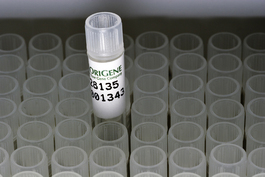RAGE (AGER) (NM_001206966) Human Untagged Clone
CAT#: SC331723
AGER (untagged) - Homo sapiens advanced glycosylation end product-specific receptor (AGER), transcript variant 9
"NM_001206966" in other vectors (2)
Product Images

Specifications
| Product Data | |
| Type | Human Untagged Clone |
| Tag | Tag Free |
| Symbol | AGER |
| Synonyms | RAGE; SCARJ1 |
| Vector | pCMV6 series |
| Sequence Data |
>NCBI ORF sequence for NM_001206966, the custom clone sequence may differ by one or more nucleotides
ATGGCAGCCGGAACAGCAGTTGGAGCCTGGGTGCTGGTCCTCAGTCTGTGGGGGGCAGTAGTAGGTGCTC AAAACATCACAGCCCGGATTGGCGAGCCACTGGTGCTGAAGTGTAAGGGGGCCCCCAAGAAACCACCCCA GCGGCTGGAATGGAAACTGAACACAGGCCGGACAGAAGCTTGGAAGGTCCTGTCTCCCCAGGGAGGAGGC CCCTGGGACAGTGTGGCTCGTGTCCTTCCCAACGGCTCCCTCTTCCTTCCGGCTGTCGGGATCCAGGATG AGGGGATTTTCCGGTGCCAGGCAATGAACAGGAATGGAAAGGAGACCAAGTCCAACTACCGAGTCCGTGT CTACCAGATTCCTGGGAAGCCAGAAATTGTAGATTCTGCCTCTGAACTCACGGCTGGTGTTCCCAATAAG GTGGGGACATGTGTGTCAGAGGGAAGCTACCCTGCAGGGACTCTTAGCTGGCACTTGGATGGGAAGCCCC TGGTGCCTAATGAGAAGGGAGTATCTGTGAAGGAACAGACCAGGAGACACCCTGAGACAGGGCTCTTCAC ACTGCAGTCGGAGCTAATGGTGACCCCAGCCCGGGGAGGAGATCCCCGTCCCACCTTCTCCTGTAGCTTC AGCCCAGGCCTTCCCCGACACCGGGCCTTGCGCACAGCCCCCATCCAGCCCCGTGTCTGGGAGCCTGTGC CTCTGGAGGAGGTCCAATTGGTGGTGGAGCCAGAAGGTGGAGCAGTAGCTCCTGGTGGAACCGTAACCCT GACCTGTGAAGTCCCTGCCCAGCCCTCTCCTCAAATCCACTGGATGAAGGATGGTGTGCCCTTGCCCCTT CCCCCCAGCCCTGTGCTGATCCTCCCTGAGATAGGGCCTCAGGACCAGGGAACCTACAGCTGTGTGGCCA CCCATTCCAGCCACGGGCCCCAGGAAAGCCGTGCTGTCAGCATCAGCATCATCGAACCAGGCGAGGAGGG GCCAACTGCAGGTGAGGGGTTTGATAAAGTCAGGGAAGCAGAAGATAGCCCCCAACACATGTGA |
| Restriction Sites | SgfI-MluI |
| ACCN | NM_001206966 |
| OTI Disclaimer | Our molecular clone sequence data has been matched to the reference identifier above as a point of reference. Note that the complete sequence of our molecular clones may differ from the sequence published for this corresponding reference, e.g., by representing an alternative RNA splicing form or single nucleotide polymorphism (SNP). |
| Product Components | The cDNA clone is shipped in a 2-D bar-coded Matrix tube as dried plasmid DNA. The package also includes 100 pmols of both the corresponding 5' and 3' vector primers in separate vials. Every lot of primer is tested to provide clean sequencing of OriGene TrueClones. |
| Reconstitution | 1. Centrifuge at 5,000xg for 5min. 2. Carefully open the tube and add 100ul of sterile water to dissolve the DNA. 3. Close the tube and incubate for 10 minutes at room temperature. 4. Briefly vortex the tube and then do a quick spin (less than 5000xg) to concentrate the liquid at the bottom. 5. Store the suspended plasmid at -20°C. The DNA is stable for at least one year from date of shipping when stored at -20°C. |
| Reference Data | |
| RefSeq | NM_001206966.1, NP_001193895.1 |
| RefSeq Size | 1365 bp |
| RefSeq ORF | 1044 bp |
| Locus ID | 177 |
| Cytogenetics | 6p21.32 |
| Protein Families | Druggable Genome, Secreted Protein, Transmembrane |
| Gene Summary | 'The advanced glycosylation end product (AGE) receptor encoded by this gene is a member of the immunoglobulin superfamily of cell surface receptors. It is a multiligand receptor, and besides AGE, interacts with other molecules implicated in homeostasis, development, and inflammation, and certain diseases, such as diabetes and Alzheimer's disease. Many alternatively spliced transcript variants encoding different isoforms, as well as non-protein-coding variants, have been described for this gene (PMID:18089847). [provided by RefSeq, May 2011]' Transcript Variant: This variant (9, also known as RAGE_v10) lacks the penultimate coding exon, and uses alternate splice sites at other exons at the 3' end compared to variant 1. This results in a frame-shift and a shorter isoform (6, also known as esRAGE and soluble RAGE) with a distinct C-terminus compared to isoform 1. Variants 6 and 9 encode the same isoform. Sequence Note: This Refseq, containing two in-frame translation initiation codons (at nt 8-10 and nt 101-103), is annotated with a CDS starting from the downstream AUG (dAUG) because the AGE receptor encoded by this gene is a known type 1 transmembrane protein requiring signal peptide for its function, and a signal peptide of 22 aa is predicted for the dAUG initiated protein. Translation initiation from the upstream AUG (uAUG) will add an extra 31 aa to the N-terminus, and no signal peptide is predicted for the uAUG initiated protein. |
Documents
| Product Manuals |
| FAQs |
Resources
Other Versions
| SKU | Description | Size | Price |
|---|---|---|---|
| RC233835 | AGER (Myc-DDK tagged) - Homo sapiens advanced glycosylation end product-specific receptor (AGER), transcript variant 9 |
USD 420.00 |
|
| RG233835 | AGER (GFP-tagged) - Homo sapiens advanced glycosylation end product-specific receptor (AGER), transcript variant 9 |
USD 460.00 |
{0} Product Review(s)
Be the first one to submit a review






























































































































































































































































 Germany
Germany
 Japan
Japan
 United Kingdom
United Kingdom
 China
China
